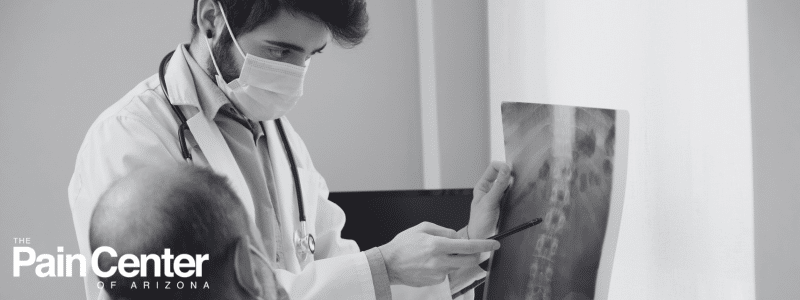
TPC Lumbar Laminectomy targets pain caused by nerve compression. This involves removing vertebral bone or disc material in the spine, causing pressure on the spinal cord. In this blog, we’ll look further into the components of a lumbar laminectomy and consider the following:
- What is lumbar laminectomy?
- The purpose of lumbar laminectomy
- Are you a candidate for lumbar laminectomy?
- Preparing for a lumbar laminectomy
- What to expect during the lumbar laminectomy procedure
- Recovery process after lumbar laminectomy
What is Lumbar Laminectomy?
Essentially, lumbar laminectomy involves creating a small incision where compression is occurring in the lumbar region. Once exposed, the surgeon uses small surgical tools to remove the source of compression, which may be a vertebral bone segment or disc material. After the compression is released, the area can be stitched up, and you’ll be on your way into the recovery phase.
Is a Laminectomy a Major Surgery?
Our lumbar laminectomy is minimally invasive and is considered a minor spine surgery. The procedure takes less than a few hours and only requires small incisions to reach the problem area.
The Purpose of Lumbar Laminectomy
Lumbar laminectomy aims to successfully remove nerve compression from the lumbar region, whether this is due to issues with the bone or discs. By eliminating the source of compression, the pressure on the nerves will go away, eliminating any pain or discomfort it is causing.
Conditions Treated by Lumbar Laminectomy
Several conditions can create compression on the spinal nerves, requiring treatment like a laminectomy to fix. The most common health conditions that lumbar laminectomy treats include:
- Ruptured or herniated disks
- Vertebral compression fractures
- Hematoma (Accumulation of blood)
- Spinal stenosis
- Bone spurs
- Abscesses (pus)
Are You a Candidate for Lumbar Laminectomy?

When inquiring about lumbar laminectomy, your doctor will check your eligibility to ensure it fits your situation and condition best. Patients must be experiencing nerve compression and have not responded to non-surgical treatments.
Some critical factors to consider for ineligibility are your past and current health conditions that exist alongside pressure on the nerve roots. If you have multiple medical comorbidities, this can make the procedure too risky.
There’s no age limit for lumbar laminectomy, but the younger the patient, the higher the likelihood they’ll need a reoperation in the future. Likewise, elderly patients may face a higher risk of complications.
Your doctor may not approve you for decompression surgery if you’re a long-time smoker. One study revealed that smoking was the strongest predictor for reoperation in patients who underwent a laminectomy.
Preparing for a Lumbar Laminectomy
Although lumbar laminectomy is a minimally invasive procedure, you still need to take the necessary steps to prepare your body for the surgery.
Steps to Take Before Your Surgery
- Avoid Eating and Drinking the Night Before Surgery. Refer to your doctor’s instructions on food and drinks before surgery. An empty stomach helps prevent complications from arising, such as aspiration, although it is rare.
- Stop Certain Medications. Your doctor will let you know which medications must be halted before, during, and after your procedure. For example, some types of medication can increase the risk of blood clots.
- Stop Smoking or Tobacco Product Use. Cigarettes and tobacco can hinder bone growth and decrease the success rate of the lumbar laminectomy. Your bones must be healthy to have the strength to heal following the surgery.
- Prepare a Ride Home. You should be able to go home the same day of your procedure. That said, you’ll still be weaning off the anesthesia and will need a designated driver to take you home safely.
The Risks and Benefits of Lumbar Laminectomy
When you consult with one of our professionals, we’ll examine whether the benefits outweigh the risks for your particular condition. The uncommon but still possible risks of a laminectomy include instances like blood clots and infection. If you have pre-existing health problems or lifestyle factors that put you at risk of these complications, we may refer you to a different type of spine treatment.
Aside from the few individuals who aren’t eligible for surgery, lumbar laminectomy offers various benefits that increase your quality of life. It aims to eliminate the following problems:
What to Expect During the Lumbar Laminectomy Procedure

During the procedure, you’ll be under general anesthesia, which will make the entire process go by quickly and painlessly. Using small surgical instruments, your surgeon will create a small incision to the problem area and remove parts causing compression. By the time you’re conscious again, you’ll be stitched up and ready to begin recovery.
Recovery Process After Lumbar Laminectomy
Your doctor will provide you with a detailed plan for your recovery, including important check-ups, required physical therapy sessions, and at-home instructions.
You’ll be restricted from certain movements for a time and need to avoid lifting heavy objects, bending, and stretching. As you go along your recovery timeline, you’ll slowly be able to get back to your everyday life.
What Research Shows About Patient Results
Did you know?
- In a study, patients saw meaningful improvements in back pain, leg pain, radiculopathy, motor weakness, and numbness after lumbar laminectomy.
- Out of 2,699 patients who underwent lumbar laminectomy surgery, the vast majority saw improvement in leg and back pain.
- Medical experts report laminectomy to have:
- A 90% success rate
- 75% patient satisfaction rate
- Lamintecomy is the preferred procedure used to treat spinal stenosis.
FAQs
How bad is pain after lumbar laminectomy?
Patients mainly report minor back pain at the incision site following the procedure. To combat this, your doctor will prescribe you pain medication to suppress the post-op pain and discomfort as your body recovers.
How long does it take to recover from a lumbar laminectomy?
Returning to your normal mobility and function will take approximately 4 to 6 weeks. This time can differ depending on the severity of compression and a person’s health history.
Can you walk normally after laminectomy?
You may find walking tiring or uncomfortable immediately after and during the first days following surgery. Following your doctor’s guidance and gradually increasing your daily steps, you can expect to resume normal walking, sitting, and bending within 4 to 6 weeks.
Are there permanent restrictions after a laminectomy?
Within the first several weeks, you’ll need to avoid bending and lifting to prevent harming the healing process. These restrictions are implemented to give you the most optimal results from the procedure.




